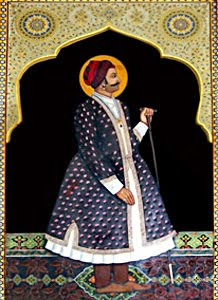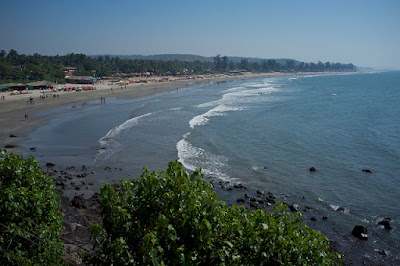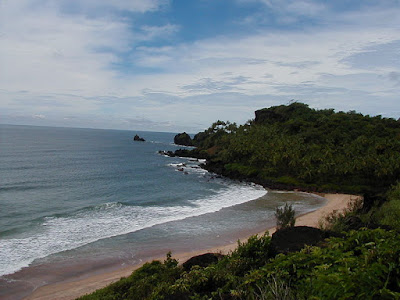Category
- Archive (236)
- Best of India (156)
- Eat Stay and Shop (5)
- From Team (21)
- Historical (64)
- Indian Festivals (173)
- Pilgrimage (33)
- Travel Tips (8)
- Weekend Spots (34)
- Wildlife (8)
Popular Posts
Copyright @ Clear Car Rental Pvt. ltd.. Powered by Blogger.
Blog Archive
History of Nasik

History of Nasik
Situated on the banks of Godavari River, Nasik is one of most prominent Hindu pilgrimage centers in India. According to mythology Nasik was the abode of Lord Rama during his period of 14 years of exile. Nasik is believed to be the same place where Laxman (brother of Lord Rama) cut the nose of Supernakha, a sister of demon Ravana and this incidence is considered to have led the place to be known as Nasik. Sita Gumpha located near Nasik serves as another reference of Ramayana. Sita Gumpha is the place form where Sita (the wife of Rama) was abducted by Ravana.
Around the year 150 BC Nasik was believed to be the place of largest market in India. In 1487 the region came under the rule of Mughal. During the Mughal rule Nasik was known as Gulshanabad. Gulshanabad is a Persian word meaning the city of rose gardens. It was from this place that flowers of rose were sent to Aurangzeb the Mughal emperor. It was during the rule of Peshawa the city was again known as Nasik. Peshwa could not hold the region long and lost it to the British rule. Nasik under the rule of British saw many development works. in 1840 one of most modern library was found in Nasik. During the 1960’s several event occurred in Nasik. In 1862 Nasik witnessed its first railway station being built; in 1864 Nasik Municipality was established, while in the year 1869 Nasik was made separate district.
British continued to rule Nasik until the independence of India in 1947. Nasik during the British rule witnessed several social and historical events. It also became places of active national movement for the freedom of India. In December 1909 Anant Kanhere, a freedom fighter shot dead Jackson who was then deputed as the collector of Nasik. Anant Kanhere along with other people involved in the killing of Jackson was soon capture by the British and were sentenced to death. Nasik also witnessed a major social movement in the year 1930 when Dr. Babasaheb Ambedakar took out a Satyagraha for the entry of dalit people in to the Kala Ram temple. This social movement is popularly known as Kala Ram Mandir Satyagraha. After the independence of India in 1947 the city of Nasik has grown in to a big city with many industrial units and prominent institutions being situated there.
Tag :
Historical,
History of Jaipur Rajasthan
 |
| Maharaja Sawai Jai Singh II
Maharaja Sawai Jai Singh II
Maharaja Sawai Jai Singh II
|
During ancient days Jaipur came under matsya Kingdom, in modern times Jaipur was laid during the reigon of Maharaja Sawai Jai Singh II in the year 1727. Originally Maharaja Jai Singh ruled between 1699-1744 from Amber (located 11 Kms. From Jaipur). When the need arise to build a new capital Jai Singh deployed Architect Vidyadhar Bhattacharya who could design the whole city according to Vastu Shatra.
The construction of Jaipur actually started in the year 1727 and it took about 4 years to complete the important palaces roads and squares. Two blocks out of nine were used for royal palaces and state buildings, rest seven were used for public dwellings. When Prince of Wales visited Jaipur in 1876 the whole city was painted pink to welcome him. The state buildings and Main market avenues still appear pink.
Tag :
Historical,
Culture of Jaipur

Jaipur Culture

The city which once had been the capital of the royalty now is the capital city of Rajasthan. Jaipur is a culturally vibrant city. Jaipur culture is well blended with tradition and modern. Jaipur shows colors of Rajasthan culture at one hand and cosmopolitan in other.
Culture of Jaipur unfolds legacy of the royal past. It is important to know about traditions, culture and customs of the Pink city while planning to visit Jaipur. Despite conversion of Jaipur into a metropolitan one, the Royal city is still continuing with surprising traditions and customs of the old days.
As per rajasthani culture, Jaipur culture is also a blend of various tribes from ancient Indus Valley civilization to modern day settlers of post partition India. The culture is a broad spectrum adoption of habits, including habits of Bhil Forest dwellers, Jain Merchants Princes, Cultivators of Jats and Gujjar origin, Muslim Craftsmen and Aristocratic Rajput Warriors who migrated from elsewhere to settle in Rajasthan and provide their distinguished color to the local culture. All the settlers came absorbed the rajasthani legacy and provided their tan to the already mixture of various culture. People here are simple and tough and are adopted to bear the harsh climatic extremes. They wear colorful dresses and celebrate life as it comes by. The culture is best experienced during the fairs and festivals of the land.
Tag :
Indian Festivals,
Culture of Kanpur
Located at the banks of Ganga River in Uttar Pradesh. Kanpur is one of the important industrial centers of North India. Formerly small towns around Kanpur jajmua and Bhitoor were more famous than Kanpur. Kanpur was an irrelevant village in 18Th century. But the turning point in its history came when Moghuls lost this land to British in 1801. Kanpur slowly became an important defense headquarters of British army and later transformed into an Industrial hub. Kanpur was actively involved in India’s independence struggle. Many poets, composers, and other freedom fighters were from Kanpur.
Valmiki ashram at Bhitoor is famous as Sita Mata wife of Lord Rame stayed here with her two sons Luv & Kush. Today Bhitoor is a tourist spot where Ganga Mela is celebrated on 8Th day after Holi festival. People throw colors and greet each other they take holy bath in the Ganga River. The festival is celebrated in memories of the revolutionaries who were released by the British government after imprisonment for 1857 revolution.
Tag :
Indian Festivals,
History of Kanpur
Kanpur is popular city in Uttar Pradesh.The written history of Kanpur city is available from the 13Th century, though before that its surrounding areas find their mention in many records. Like Bhitoor which lies 8 Kms from IIT Kanpur finds its reference in vedic scriptures. It is said that after creating the universe Lord Bramha established a Lingam there and performed Ashvamedha Yagna. Ramayan was written by Sage Valmiki at the Valmiki ashram in Bithoor. On exile Sita devi stayed and was bringing up her sons Luv and Kush here in Valmiki Ashram. Another place Jajmua is 10 Kms east of the city of Kanpur, remains of an ancient fort of vedic times has been unearthed here. An ancient temple famous for its architecture and wood work, is located 20 Kms from Kanpur Central Railway Station in Shivpuri town. In 1765 Shuja-ud-daula (Nawab of Awadh) lost to British forces in Jajmua. Britishers had slowly started establishing in Kanpur and slowly moved their forces in to protect their properties. In 1801 Kanpur was handed over to British by a treaty with Nawab Saadat Ali Khan of Awadh. Slowly Kanpur was developed as an important military station of Britishers. An incident at the start of Indian Independence movement happened here in 1857 when 900 British were kept as prisoners for 22 days at the Satti Chaura Ghat and later when they were released for going to Allahabad a massacre took place in which many English men were killed and about 200 women and children were captured in a ladies home and killed later. A British general Neil Retook committed series of retaliations against Indian sepoyes and grneral public who were caught for the act. After 1857 Kanpur started becoming an important center for leather products and textiles. Slowly Kanpur became an Industrial city. There are many Defence Ordinance factories in Kanpur. It is the only industrial city in the state of Uttar Pradesh.
Tag :
Historical,
Tourist Places in Goa
Tourist Places in Goa:
Goa - one of the popular and most visited tourist destination in the country because of it's enchanting and beautiful coastline with long sandy beaches, casinos, river cruises, exotic beach resorts, water sports and plenty of other things. Whether It's a tour with friends or family you'll find so many things to
explore at this land of sun, sand and beaches.
explore at this land of sun, sand and beaches.
Arambol :
 |
| Arambol beach Image courtesy: Aleksandr Zykov |
Arambol is located in the northern region of Goa. It lies 32 km north-west of Mapusa and Chapora, approximately 50 km from Panaji (the capital) and 12 km from Chopdem and at a one hour drive from Dabolim airport.
Vasco-da-Gama :
 |
| St Andrew church, Vasco da Gama Image courtesy: www.ambiencebuilders.com |
As the name suggests, Vasco-da-Gama city inherited its name from the Portuguese explorer and the former viceroy, Dom Vasco-da-Gama. Located at close proximity to Marmagoa harbor and Zuari river, the city was originally called Sambhaji. This coastal town came under Portuguese rule in 1543 and evolved as a leading export-import trade centre for India on a global platform. Vasco, today, is one of the largest industrial and commercial cities of Goa. Vasco has always been one of the busiest ports on the western coast of India. The town of Vasco-da-Gama has a 400-year-old St Andrew Church.
Canacona :
 |
| Canacona beach coastline Image courtesy: www.wikitravel.org |
The Canacona region was earlier a part of the Soonda kingdom (a remnant of the powerful Vijayanagar Empire of the Hampi). But when it was defeated by Hyder Ali of Mysore, the king of Soonda surrendered the territory to the Portuguese in 1791. Canacona merged with Goa in 1794. With Chaudi, as its capital today, Canacona is the gateway to many of Goa's southern tip beaches including Agonda, Palolem and Rajbhag.
Ponda :
 |
| Bondla Wildlife Sanctuary Image courtesy: www.wikimapia.org |
 |
| Shree Shanta Durga Temple in Ponda Image courtesy: www.wikitravel.org |
The famous ten temples, constructed in the 17th and 18th century, provide a boost to the tourism industry in Ponda. Several temples look relatively new as these were renovated after being destroyed by the Portuguese. The temple town of Goa, is also the gateway to Goa's wildlife sanctuaries. Apart from being a holy destination to the pilgrims, Ponda offers two wildlife sanctuaries to all the nature enthusiasts, namely the Bondla Wildlife Sanctuary and Bhagwan Mahaveer Sanctuary. Ponda also has the largest mosque in Goa.
The town emerged as an administrative centre when the Portuguese took over the area in 1791 from the king of Sonda. During the formation of the New Conquests, they annexed it along with Quepem, Canacona and Sanguem. Today, Ponda is a major tourist hub and a leading industrial city as well.
Panjim :
 |
| Arial view of Panjim Image courtesy: abcdz2000 |
Panjim is the most famous tourist destination in Goa, in terms of beaches, churches, carnivals and natural beauty. Being the capital city, it is the focal point of tourism in Goa. It is a small and charming city on the banks of silvery Mandovi River. The town has some beautiful red-blue-green-yellow roofed buildings made in Portuguese Baroque style. While its official name has been Panaji (meaning “the land that does not flood) since the 1960's, it has been called Panjim by the Portuguese, who ruled Goa for over 400 years.
Panjim was a neglected fishing village of creeks, fields and coconut trees for many centuries. It was given the status of a city and was declared the capital of Goa in 1843. The city has tree-lined cobbled streets, pretty gardens and a beautiful promenade on the river-front.
Pernem :
Pernem is predominantly a Hindu town. This small town comprises of a beautiful coastline with long sandy beaches, lagoons and coconut plantations. Being situated between the Chapora and Arondem rivers, Pernem enjoys a moderate climate throughout the year. Tourists mostly come here to visit the Hindu temples.
Konkani, Marathi, English, Portuguese and Hindi languages are spoken here, like in other parts of Goa. If you want to see beautiful Portuguese architecture in Pernem, you can go to the Terekol fort (a vital part of the Portuguese defence), located on the Maharashtran border. The beautiful Pernem coastline of long sandy beaches, lagoons and coconut plantations has few settlements spruced up for visitors.
Best time to visit Goa:
You can visit Goa anytime in the year but the best and recommended time is October to February.How to reach :
By Train:
Goa has two railway station - Vasco and Madgaon. Both of them are well connected to the major cities in India by direct trains.
 By Air:
By Air:
Dabolim airport is the nearest airport to Panjim which is 25.9 kms away. Renting a cab prior to your arrival at the airport will be best option to reach your destination from here.
 By Road:
By Road:
Goa is well connected to the major cities of India through NH4A, NH 17 and NH17A. State transport department KTC has good connectivity to other town of the Goa state. You can also hire a taxi in Goa for local sightseeing. Tag :
Best of India,





